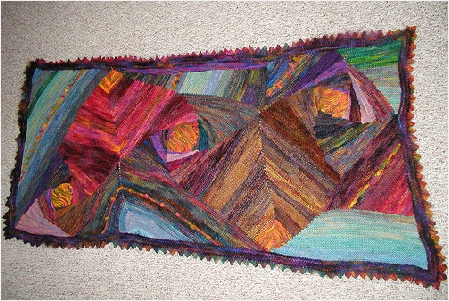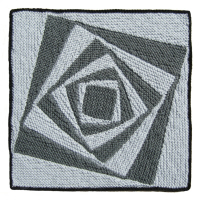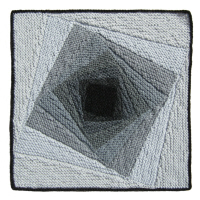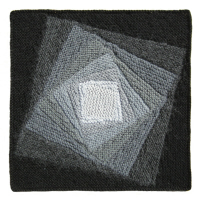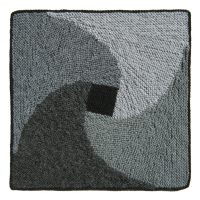

Click to read general information about afghans



Buy a pattern
for this afghan
on the order form
 Buy now
Buy now

CURVE OF PURSUIT
The design is based on the curves that are formed if four dogs set off to chase each other from the corners of a field. The path created by each dog is an equi-
This was the first design where we broke away from using shapes whose angles were all a multiple of 45 degrees.
September 2010 -
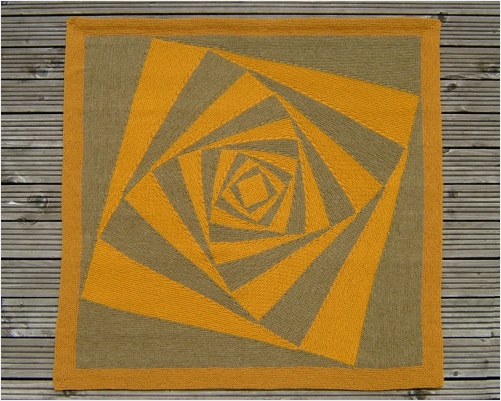


RELATED DESIGNS
PURSUIT AFGHAN
CURVE OF PURSUIT CUSHION
SHORT-

CONSTRUCTION INFORMATION
Worked in one piece, using one colour at a time.
The triangles are made by picking up stitches from the previous shapes and using a ‘short-

KNITTING INFORMATION
Use any yarn and needles, in two, or more colours.
Very different effects can be created by the choice of colours.
Scroll down for more information about
Curve of Pursuit

We have never bothered to calculate the size of the angles we used here. We knew that the angles would be the same throughout if the same process was repeated on every triangle. The triangles would be exactly the shape, but bigger, on each round. Any number of rounds could be added until the afghan reached the desired size. The amount of turn was unimportant because the overall shape would always be a square.
When the design is drawn with good straight lines it is much easier to see why it is referred to as a curve. As with many of our other designs, some allowance has to be made for the nature of the knitting. Mathematically, lines have no thickness and points have no dimension. In knitting the lines and points can be very thick, depending on the yarn used.
Mathematically the design is called a Curve of Pursuit so this was the name we gave to the afghan. Later we wondered why we hadn’t called it Trivial Pursuit so we gave that name to the cushion version. It is called a Curve of Pursuit because it represents four dogs chasing each other round a field. The dogs start from the corners of the field and chase each other’s tails. If they were to keep going they would eventually crash in the middle. The path created by each dog is called an equiangular spiral. The curves become more obvious as more points along the route are connected.
The curve is drawn from the outside to the centre. The afghan has to start at the centre and work outwards. For practical reasons it can not start at a point so starts with a square. Mathematically, this means the dogs must have stopped before they caught each other.
Click here to read a magazine article about mathematical knitting and crochet, including Curve of Pursuit.


|
|
|
These nine samples show some of the ways Curve of Pursuit can be coloured to give different effects. Some of them use slightly different techniques from those in the original pattern. In some cases this helps to eliminate the number of ends that have to be darned in. A separate document, which gives hints and tips for makig them, is available with the pattern. |
|
|
|
|
|
|
|
|
|
|
|
|
|
|
|
|
Curve of Pursuit has been one of our most popular designs, amongst knitters.
The photos below were all sent by members of the Woolly Thoughts Yahoo! Group


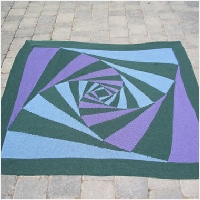
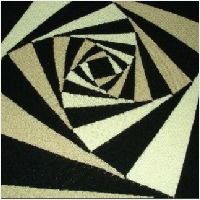
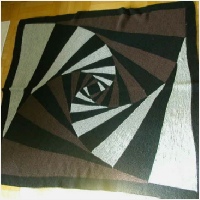


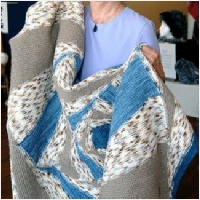


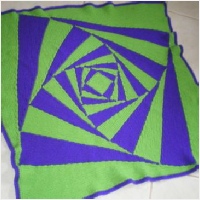
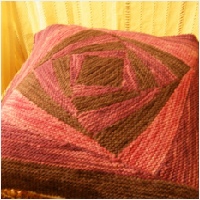

This crochet version was made by Dawn. Even though she considered it to be a disaster, she has allowed us to use her photo and words:
Curve of Pursuit....not!
Well, there it is...the sort of disaster. The silk/cotton yarn just didn't take to the pattern that I bought at all. I decided that I could do it by crocheting it and love the pattern. The picture isn't very good because I have it hung from the top corner. Anyway, the disaster is the colors. They aren't anything like the quilt I was basing it one...which I can't show you because I took a picture at the Internation Quilt show and I don't have permission to post it. Anyway....I have now decided to switch to another pattern that I will be able to use the same colors but it will look better. I have to buy a few more colors...and can't use all the colors I bought...so that means more yarn for my stash!!! Oh well......


Curve of Pursuit became even more popular after a photograph of this version, knitted by Ann Buechner, was included in Mason-
Since the advent of Ravelry, it has gone from strength to strength.
For some unknown reason it seems to be particularly popular in Norway.
Note: You need to be a member of Ravelry to access the projects there.


This artistic interpretation was created by Merrily100. She named it Many Pursuits and very kindly sent it to us as a Christmas present in 2008.
